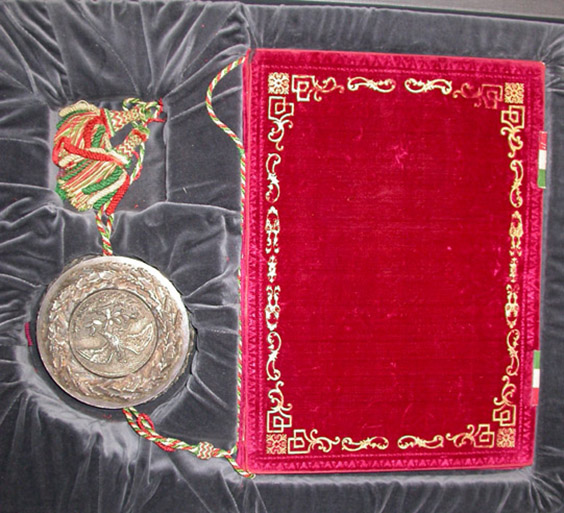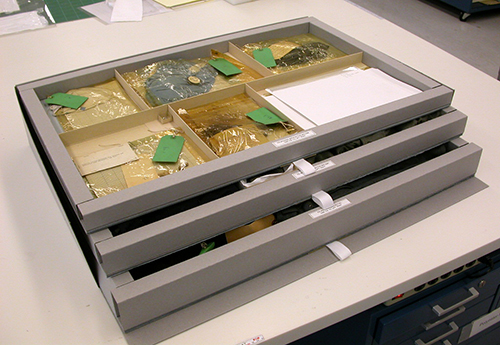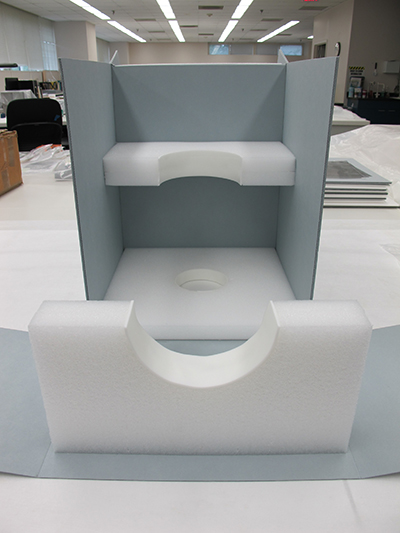
Artifacts Found in Archival Holdings
Three-dimensional objects may be found in archival records. A few general recommendations follow but detailed information about handling and storing artifacts is beyond the scope of this guidance.
Excellent information can be found in the National Park Service's Conserve O Grams.
For additional guidance on artifacts found in holdings, please refer to the links below:
- Handling
- Documentation
- Conservation of Artifacts
- Labeling
- Protective Enclosures and Storage Containers
- Internal Storage Support Methods
Handling
- Handle one artifact at a time.
- Always wear nitrile gloves. Textiles, basketry, skins, lacquered and reflective surfaces and other materials - even artifacts made of gold and platinum - can be degraded by the oils and salts left behind from handling. Nitrile gloves facilitate handling slippery materials like glass and ceramics by providing some grip.
- Assess how to pick up an artifact before handling it. Avoid areas of applied decoration, where two sections or components join or are attached to each other, areas that appear weak, or surfaces that are flaking or lifting.
- Do not lift an artifact by its rim or pick it up by a handle or other protruding part. These areas and attachments are often weak and can break off.
- Support the artifact with both hands. It is often safer to place one hand on two opposing sides, or a hand on one side and the other beneath the artifact.
- Keep the artifact over a table or other surface. Place an artifact on a flat surface that supports its entire base or length.
- Do not place an artifact on top of an archival record or other artifacts.
- Resist the temptation to move parts of an artifact or make it “work.” Moving parts places stress on areas that are often fragile and can cause abrasions and breaks.
- Talk to an objects conservator about damages or areas that might worsen over time.
Documentation
Document areas that appear to be weak or deteriorating with digital photographs. Snapshots of damage or areas of concern can be part of the record. A technical resource for the formal set up and management of artifact photography is Digital Photography for Object Documentation by the Sustainable Heritage Network.
Conditions of particular concern include:
- surfaces or layers that are powdery, flaking, peeling or detaching;
- loose or detached parts or attachments that are weak;
- tears, cracks and breaks in textiles, ceramics, basketry, wooden objects, or any other material;
- artifacts that have been weakened by crushing or other distortion such as hair mementoes, purses and bags, feathers;
- areas of aggressive metal corrosion indicated by bright green corrosion deposits on copper, bronze, brass, or silver or moist areas on iron artifacts;
- signs of insect infestation such as shed skins which might be seen on skins, hair mementoes, wool and silk, wood, basketry, and other protein-based materials.
Be aware that artifacts may have been made with hazardous materials or may be contaminated with hazardous substances. Geological specimens may be radioactive, radium was used in instrument dials and some ceramics and paints prior to 1970, mold may be present on any organic material, and insecticides including arsenic, mercury and DDT may have been used during taxidermy and were common as a preventive measure. Wear nitrile gloves, wash your hands after handling artifacts, and avoid disturbing loose or powdery surfaces.
Conservation of Artifacts
Do not attempt to clean or repair any artifact. You may remove important evidence and can easily damage an artifact. Always contact a conservator for advice on how to proceed.
- Keep in mind that what appears to be damage may be a typical result of use or may provide evidence of the object's history. Make no attempt to improve the appearance of an artifact found in an archival collection or to make an apparently damaged object look new again.
- Never attempt to reattach or glue broken pieces. Do not use adhesives on any artifact.
- Avoid trying to fit together broken parts in an effort to see if a piece is missing. Contact between broken surfaces often causes small losses that complicates conservation treatment. Wrap pieces separately for storage.
- Objects that have been crushed and misshaped often require humidification or other interventions to reform their shape. Do not force a damaged object into what you think is a more original shape. Store a distorted object as is.
- Metals often age to an even and protective oxide patina. Any change in the surface may be evidence of use. Never attempt to clean or polish any metal artifact.
Labeling
Label the storage container or the protective wrapping; ask for advice on labeling the artifact itself.
- If necessary, use paper tags to identify artifacts. Place the tag inside an artifact, gently loop it through a stable opening, such as a cup handle or a buttonhole, or slip it over a stable protrusion such as a knob.
- Do not write on an artifact unless you have been trained in standard museum methods for applying identification numbers.
Protective Enclosures and Storage Containers
Store artifacts in an archival box to provide physical protection and buffer from dust, light, and adverse ambient conditions. Many box sizes are available commercially and custom boxes can be made from archival materials.
- Depending on the number and size of artifacts and the amount of room available in an archival box, the well created by using a spacer board may provide enough space to store artifacts in the box with the associated documents.
- When enough space is not available in the box housing associated records, consider using a cubic foot artifact box with divided trays to house multiple smaller artifacts.
- Ensure that the box, tray, or well is large enough for each artifact. Do not overcrowd a box or force an artifact into a box in order to close the lid. Use additional boxes or a larger one as needed.
- Do not fold, crease, bend, tear, crush, or otherwise deform an artifact or separate attached parts of an artifact to make it fit into a space. Alter the tray or cell or use a larger box.
- Some pliable materials such as flat textiles can be rolled or folded, but the box needs to be large enough to allow storage without multiple or tight rolls or folds.
- Always place heavier artifacts in the bottom of the box. Do not place a heavier item on top of a more delicate one.
- When housing multiple associated artifacts, try to store objects of similar size and weight together. For example, use one box for metal equipment, another for ceramics and another for textiles.
- Pad out empty space in the well or box with rolls of tissue paper to keep the artifacts from shifting and causing damage to one another.
Internal Storage Support Methods
Individually wrap artifacts before packing into boxes or crates. If the artifact is in separate parts, wrap each one.
- Use unbuffered acid-free tissue to protect the surface of each artifact and preserve its shape. Unbuffered tissue is preferred because it is soft and smooth. Also buffered tissue can damage protein-based materials such as silk, wool, and animal skins, which are sensitive to higher pH levels.
- Do not roll the artifact in tissue. Instead place the artifact on several layers of tissue and fold the tissue around the object. Ends can often be tucked under the artifact to secure the fold.
- Wrap the artifact loosely but securely. Avoid placing pressure on the artifact but don’t leave voids that allow the object to move around in its wrapping or makes it difficult to pick up the artifact securely.
- Pad out any folds in a textile with tissue rolls to prevent permanent creases from forming over time. It may also be possible to roll a flat piece of textile around a pad of tissue. Discuss padding out fragile, torn and fraying textiles with a conservator.
- If the material remains very pliable, pad out soft three-dimensional artifacts such as a shoe or bag with unbuffered tissue paper to help hold its shape. Pad gently and don’t stress the material or seams by over-padding. If small cracks form, a tear or weak attachment worsens, or other damage is occurring, stop and store the artifact without padding.
- Isolate each part of an individual artifact with tissue paper to prevent contact abrasion. As examples, place a piece of tissue paper between a lid and the body of an artifact, and isolate each shoe in a pair with tissue. Alternatively wrap pieces separately.
Inserts inside the container that support the artifact can be made of a variety of materials that are chemically inert, and perform the job of holding or supporting the part of an artifact while it is in storage. The inserts should be covered to ensure that they are smooth and soft. Consult The Canadian Conservation Institute (CCI) Notes for storage suggestions by type of artifact.


